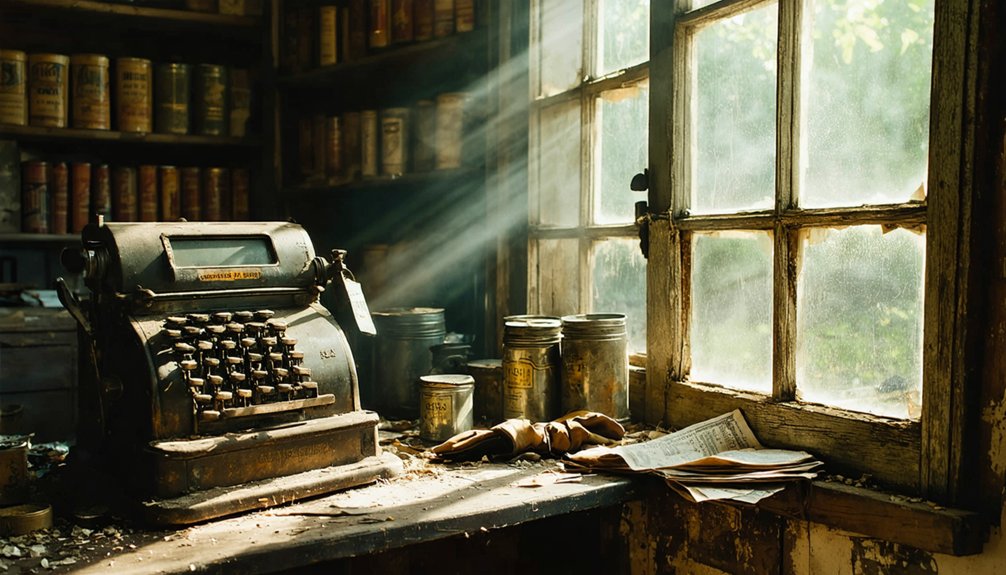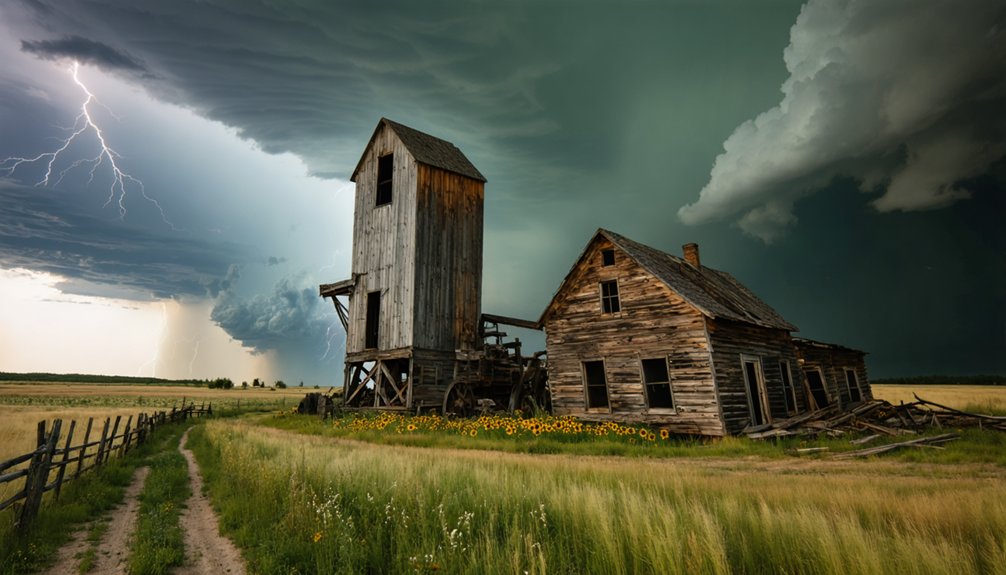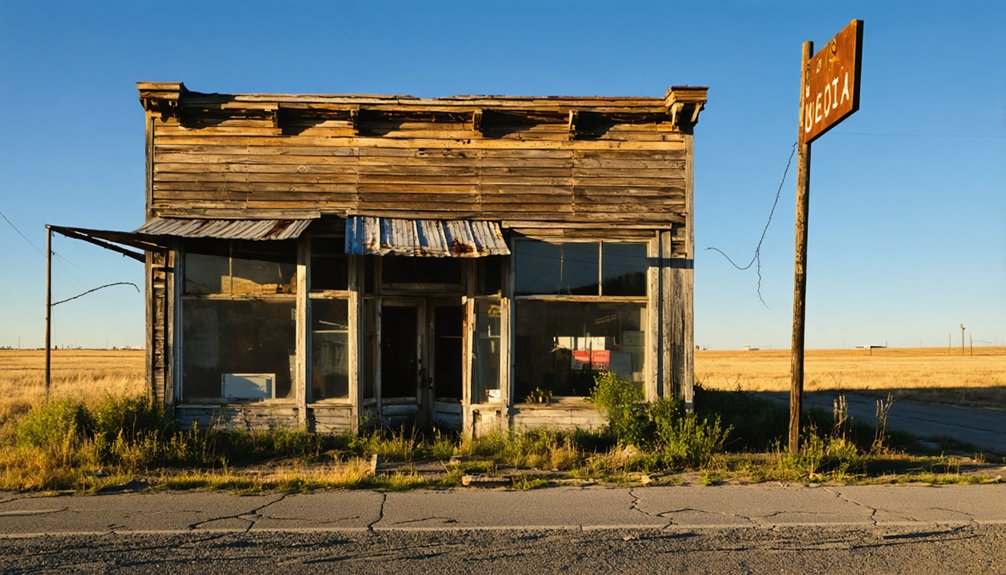You’ll find Hammer’s haunting remnants in South Dakota’s remote prairie landscape, where it once thrived as a frontier settlement. The town’s history intertwines with mining booms, railroad expansion, and the Homestead Act of 1862. Weather played a cruel role in its abandonment, with brutal winters reaching -40°F and devastating tornados forcing residents to leave. Today, deteriorating structures, including its renowned chapel, offer glimpses into prairie life’s harsh realities and untold stories.
Key Takeaways
- Hammer was established during South Dakota’s agricultural expansion, with settlers drawn by the Homestead Act’s offer of 160 acres.
- The town’s development was influenced by mining activities and railroad connections, particularly through the Black Hills & Fort Pierre Railroad.
- Community life centered around farming, ranching, and social gatherings, with the local chapel remaining as the most significant surviving structure.
- Harsh weather conditions, including severe blizzards and extreme temperature fluctuations, contributed significantly to the town’s eventual abandonment.
- Visitors can explore Hammer’s ruins via dirt roads, but must exercise caution around unstable structures and historic mining hazards.
The Rise and Fall of a Prairie Settlement
While the exact origins of Hammer, South Dakota remain largely undocumented, this prairie settlement likely emerged during a period of agricultural expansion that characterized many small towns across the state.
Like many similar communities, you’ll find that settlement patterns followed the promise of economic opportunities, with determined pioneers establishing roots in the challenging prairie environment. Similar to the hundreds of ghost towns that dot the Black Hills region, Hammer struggled to maintain its population over time. Drawn by the Homestead Act of 1862, settlers were given the chance to claim 160 acres of land to build their future.
The town’s story mirrors that of countless other South Dakota settlements, where initial hope and resilience faced the harsh realities of frontier life.
You can trace its eventual decline to common factors that plagued many prairie towns: economic hardships, possible environmental challenges, and the critical impact of being bypassed by major transportation routes.
Without sustainable industries to support long-term growth, the community gradually lost its population to more prosperous areas.
Mining and Railroad Legacy
Three major mining developments shaped Hammer’s industrial legacy: the discovery of the Homestake deposit in 1876, the formation of the Homestake Mining Company, and the establishment of critical railroad infrastructure.
You’ll find that Homestake’s mining technology revolutionized the region’s gold extraction methods, moving beyond simple placer mining to advanced hard-rock ore processing using mercury amalgamation and innovative crushing techniques. The mine’s remarkable output made it responsible for 10% of global gold production over its 125-year history. Workers utilized steel-toed shoes and other safety equipment to maintain remarkably low accident rates.
The company’s railroad expansion through the Black Hills & Fort Pierre Railroad transformed local commerce and settlement patterns.
The Black Hills & Fort Pierre Railroad’s expansion reshaped trade networks and community development throughout the region’s emerging frontier settlements.
You can trace how this rail system, built to transport supplies, ore, and timber, gave Homestake unprecedented control over regional resources.
The railroad’s reach extended to the eastern Dakota territory, cementing the company’s dominance in mining operations and fundamentally altering the economic landscape of settlements like Hammer.
Daily Life in Early Hammer

In early Hammer, you’d find the community gathering regularly at multipurpose buildings that served as churches, lodge halls, and social centers, where residents forged bonds through shared celebrations and religious services.
Your typical workday would’ve involved laborious tasks like farming, ranching, or supporting local businesses such as general stores and saloons, with many residents taking on multiple roles to make ends meet.
The I.O.O.F. lodge played a central role in organizing community events and fostering mutual aid among settlers who depended on each other’s support to overcome the challenges of frontier life.
Community Gatherings and Events
During the early days of Hammer, South Dakota, community gatherings served as the lifeblood of social interaction and cultural connection.
You’d find neighbors coming together at the community center for lively dances, theatrical productions, and sporting events that fostered town pride and unity.
The town’s community traditions included harvest festivals, where local farmers celebrated successful growing seasons, and cultural festivals that honored the region’s heritage.
Local volunteer groups organized these festival celebrations, while traveling performers brought entertainment from beyond Hammer’s borders.
Similar to Rochford’s Moonshine Gulch Saloon, the local gathering spots became cherished places where residents could unwind and socialize after long days of work.
The town’s churches played a central role in bringing people together, hosting regular social events and holiday celebrations.
At these gatherings, you’d experience the warmth of rural South Dakota life, where community bonds were strengthened through shared experiences and collective memories.
Much like the nearby town of Owanka, which had two churches serving its residents, religious institutions were vital to maintaining social connections in these small prairie communities.
Work and Daily Tasks
Beyond the social gatherings that defined Hammer’s community spirit, the town’s daily existence revolved around demanding physical labor and constant maintenance tasks.
You’d find miners working long hours in harsh conditions, operating shafts and hoists while processing ore through cyanide vats. The intense mining labor shaped every aspect of life in this Black Hills town. Like the workers at Awanka’s grain elevator, handling crops and loading trains was a vital part of the local economy.
Your domestic chores would’ve included fetching water, chopping wood, and preserving food through smoking or canning.
Women and children shared these responsibilities while maintaining homes built from local timber. You’d need to stay prepared for harsh winters and maintain critical infrastructure like roads and water supplies.
The town’s survival depended on everyone’s contribution, from storekeepers managing essential supplies to residents performing communal repairs on buildings and equipment.
Architectural Remnants and Historical Sites
While most South Dakota ghost towns have vanished entirely, Hammer’s architectural remnants offer glimpses into its early 1900s past through deteriorating structures and foundational ruins.
You’ll find evidence of architectural decay in the roofless buildings, abandoned railroad tracks, and a weathered grain elevator that once anchored the town’s economy.
The historical significance of these structures reflects the German-influenced design common in Black Hills settlements, with simple wooden-frame construction and brick storefronts dotting the landscape. Much like Rockerville, the town showcases remnants of mining equipment scattered throughout its ruins.
The chapel stands as the most renowned surviving structure, while grave sites nearby serve as sobering historical markers. Like the Mystic Reduction Mill, many of these historic structures were eventually demolished, leaving only traces of their former grandeur.
If you’re exploring these remnants, remember they’re mostly on private property and require respectful distance for both preservation and safety.
Natural Elements That Shaped Hammer’s Destiny

You’ll find Hammer’s eventual abandonment was heavily influenced by the region’s harsh weather patterns, including severe blizzards and prolonged droughts that made daily life increasingly challenging.
The town’s location in the Black Hills, while rich in natural resources, created significant isolation due to the rugged terrain and limited accessibility during extreme weather conditions.
These geographic barriers, combined with the unpredictable climate of South Dakota’s semi-arid environment, ultimately contributed to the settlement’s decline as residents sought more hospitable locations.
Weather’s Relentless Impact
As severe weather pummeled the small town of Hammer, South Dakota, its residents faced an unrelenting barrage of natural challenges that would ultimately contribute to the settlement’s demise.
The weather patterns swung dramatically between brutal winters and challenging summers, creating climate challenges that tested even the hardiest pioneers. You’d have witnessed temperatures plummeting to 40 degrees below zero during winter months, while summer brought the constant threat of devastating tornadoes. A destructive F4 tornado in nearby Manchester in 2003 served as a stark reminder of nature’s raw power in the region.
- Historic blizzards, including the catastrophic storm of January 12, 1888, repeatedly isolated the community.
- Extreme temperature fluctuations damaged buildings and infrastructure through freeze-thaw cycles.
- Snowfall often exceeded a foot, blocking rail services and telegraph communications.
- Spring floods from melting snow delayed vital planting seasons into May.
- Tornadoes and high winds regularly threatened to destroy what residents had built.
Geographic Isolation Effects
Located in the northeastern reaches of South Dakota, Hammer’s geographic isolation played a decisive role in its eventual abandonment.
You’ll find that the town’s position in Roberts County, marked by flat to rolling terrain, created significant isolation challenges that hindered its sustainability. Without railroad connections or navigable waterways, you couldn’t easily transport goods or attract new settlers to the area.
The resource scarcity around Hammer compounded these problems. Unlike other South Dakota towns that thrived on mining or timber, you wouldn’t find any valuable mineral deposits or rich natural resources here.
The surrounding farmland offered limited agricultural potential, and the distance to major markets made selling crops difficult. This perfect storm of geographic constraints and limited economic opportunities ultimately pushed residents to seek better prospects elsewhere.
Exploring the Ghost Town Today
Visitors to Hammer, South Dakota encounter a quintessential Black Hills ghost town site accessible via dirt roads and forest trails in the historic mining region.
You’ll discover foundational remnants and ruins that tell the story of a once-bustling mining community, though most structures have succumbed to time. For ghost town photography enthusiasts, the site offers compelling subjects among Victorian-era architectural remains and scattered mining equipment.
- Watch for unstable ground near mine shafts and waste piles
- Stay clear of deteriorating structures to guarantee visitor safety
- Look for historic artifacts like cyanide vats and mining equipment
- Document your finds through photography without disturbing the site
- Follow preservation guidelines by avoiding climbing on fragile ruins
Your exploration requires caution and respect for both physical hazards and historical preservation, as nature continues to reclaim this indication of the Black Hills’ mining heritage.
Frequently Asked Questions
Are There Any Reported Paranormal Activities or Ghost Sightings in Hammer?
As silent as the prairie wind, you won’t find documented ghostly encounters or local legends here. There’s no credible evidence of paranormal activity in this location’s historical record.
What Happened to the Original Residents After Leaving Hammer?
You’ll find most residents’ stories followed typical migration patterns, relocating to larger towns like Deadwood and Spearfish for better economic opportunities, while others scattered across neighboring states seeking railroad and mining work.
Can Visitors Legally Collect Artifacts From the Hammer Site?
You shouldn’t collect artifacts without confirming land ownership and legal regulations first. Since artifact preservation laws vary between public and private lands, you’ll need explicit permission before removing anything.
Were There Any Notable Crimes or Scandals in Hammer’s History?
Where there’s smoke, there’s fire – but in this case, you won’t find documented evidence of any crime history or scandal details from Hammer’s past. Historical records don’t reveal notable incidents.
Does Anyone Still Own Property or Land in Hammer?
You’ll find current property ownership records unclear, though like many ghost towns, the land may have reverted to county control or private owners who don’t actively maintain or use the property.
References
- https://blackhillsvisitor.com/learn/owanka/
- https://www.youtube.com/watch?v=Glucs_Rq8Xs
- https://www.sdpb.org/rural-life-and-history/2023-08-21/some-black-hills-ghost-towns-and-their-origins
- https://www.sdhspress.com/journal/south-dakota-history-2-2/some-black-hills-ghost-towns-and-their-origins/vol-02-no-2-some-black-hills-ghost-towns-and-their-origins.pdf
- https://www.blackhillsbadlands.com/blog/post/old-west-legends-mines-ghost-towns-route-reimagined/
- https://aberdeenmag.com/2019/01/the-ghost-towns-of-brown-county/
- https://en.wikipedia.org/wiki/List_of_ghost_towns_in_South_Dakota
- https://www.onlyinyourstate.com/experiences/south-dakota/capa-ghost-town-sd
- https://www.youtube.com/watch?v=_0WNYsFLSLA
- https://www.atlasobscura.com/places/ardmore-ghost-town



